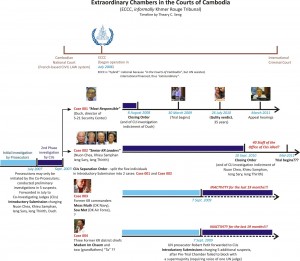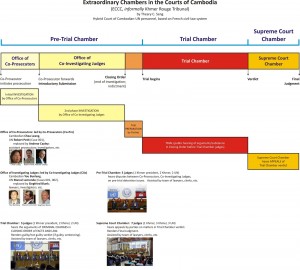Education
now browsing by category
Closing order of case 002 (continue…)
IV. COMMUNICATION STRUCTURE
- 72. The CPK Standing Committee was at the top of the Party’s nation-wide communications. It was at the centre of a system of constant information between each part of the administrative hierarchy. It issued the instructions: “Send general reports through various spearheads. Propose short reports by telegram, (all this so) the Standing Committee knows the situation in order to provide timely instructions”.206
A. CHANNELS OF COMMUNICATION
- 73. The channels of communication were meticulously organized at the level of the Centre (among ministries and offices around the Centre, within the Centre armed forces and within the Centre’s S-21 security apparatus); between the Centre and the zones (with no inter-zone communication allowed); and between zones and sectors. Communication between sectors and districts depended on available means, but was less formalized.
- 74. The distribution of messages that arrived at the Centre from outside entities was coordinated by Office K-1, where it was decided which of the leaders were to receive copies of messages which were subsequently delivered to them.207 This decision was taken by Pol Pot and his staff, who for this purpose received ingoing messages several times per day.208 According to one witness, Nuon Chea always received a copy of the messages Pol Pot had read.209
- 75. There was also frequent written communication between individual CPK leaders, most notably between Pol Pot and Nuon Chea, who used to exchange letters every one or two days.210
Zone to Centre Communication
- 76. Zones and autonomous sectors reported to the Standing Committee primarily on the agricultural situation, such as the rice harvest and on irrigation systems, the livelihood of the people and the enemy and military situation.211Secretary of Autonomous Sector 105) mentions that he sent telegrams to the Centre and that Pol Pot would send comments back to him about the arrests of cadres and about confessions.212
Posted in Education, KR Trial, Politics, Researches, Social | Comments Off on Closing order of case 002 (continue…)
Closing order of cases 002 (Nuon Chea, Kieu Samphan, Ieng Sary and Ieng Thirith) continue…
- 58. Below the level of the Centre, Democratic Kampuchea was sub-divided into a series of hierarchical administrative entities, all reporting up a vertical chain-of-command, culminating at the Centre. Immediately below the Centre were a number of large “zones”. They were subdivided into “sectors” with each of these containing a number of “districts” within which were a series of “subdistricts” and “cooperatives”.184 At each level, the zone, sector, district and subdistrict tiers of this national structure were each governed by a committee, each of which was headed by a secretary.185
- 59. Immediately after April 1975 there were six zones; North Zone, Northwest Zone, Northeast Zone, Southwest Zone, West Zone and East Zone.186 In 1977, the North Zone was renamed the Central Zone187 and a new North Zone was created.
- 60. In addition to the zones which reported directly to the Centre, the CPK created a number of “autonomous sectors” which bypassed the zone level to report directly to the Centre. These were Autonomous Sector 103 (Preah Vihear), Autonomous Sector 105 (Mondulkiri), Autonomous Sector 106 (Siem Reap), Autonomous Sector 505 (Kratie) and the Kampong Som Autonomous City (Cambodia’s principal Seaport).188 In addition, Phnom Penh itself was categorized as a distinct territory not within the formal national administrative structures, which reported directly to the Centre.189 Autonomous Sector 106 (Siem Reap) was merged with Autonomous Sector 103 (Preah Vihear) to create the New North Zone in 1977.190
Posted in Education, KR Trial, Politics, Researches, Social | Comments Off on Closing order of cases 002 (Nuon Chea, Kieu Samphan, Ieng Sary and Ieng Thirith) continue…
Khmer Rouge Tribunal: cases 001, 002, 003 and 004
- 33. As of 17 April 1975, the CPK was governed by a Statute which had been initially adopted at the Party’s first Congress, in September 1960.74 In January 1976, a new Statute75 was adopted at the Party’s Fourth Congress76 that outlined the ideology, membership, structure and organization of the Party. Within the Statute a number of state bodies were particularized: the Revolutionary Army of Kampuchea,77 the national system of Party Committees,78 the Party Central Committee,79 and “various offices and ministries surrounding the Central Committee”.80 The Party itself was governed by a Central Committee and a Standing Committee.81
Posted in Education, KR Trial, Politics, Researches, Social | Comments Off on Khmer Rouge Tribunal: cases 001, 002, 003 and 004
Emails from Canada: Sophoan Seng
Emails from Canada: Sophoan Seng
- Wednesday, 30 March 2011 15:00
- Sophoan Seng

Alberta is well known as a leading exporter of natural resources like timber and oil in Canada. Large foreign companies from the US have invested billions of dollars extracting oil and gas in this territory to make up for the shortage of oil for energy in their country. Oil deposits which are called “oil sands” are very distinctive from what is found in those oil rich countries such as Iran or Saudi Arabia in the Middle East, and the monitoring and regulations of this lucrative industry has never been neglected.
The official website of the Alberta government describes Alberta’s oil sands as the backbone of the Canadian and the global economy, adding it is a great buried energy treasure which has continuously supplied stable and reliable energy to the world. Oil sands are a naturally composed mixture of sand, clay or other minerals, including water and bitumen, which is a heavy and extremely thick, sticky oil that must be treated before it can be processed by refineries to produce usable fuels such as regular gasoline and diesel. Oil sands can be found in many locations around the globe, but the Athabasca deposit in Alberta is the largest and most developed and it has utilised the most advanced technology to produce oil.
Canada’s Facts and Statistics Department has ranked Alberta’s oil sands second after Saudi Arabia in terms of proven global crude oil reserves. In 2009, the total proven oil reserves were 171.3 billion barrels, or about 13 percent of the total global oil reserves, which is about 1,354 billion barrels. The net income in the fiscal year of 2009 for the Alberta government was more than US$3 billion in royalties from oil sands projects, which was lower than 2008 at $20.7 billion. But they project it to skyrocket and revenue to hit $15 billion in the next few years. Ultimately, about 99 percent of Alberta’s oil comes from oil sands.
Read More …
Posted in Education, Environment, Politics, Social | Comments Off on Emails from Canada: Sophoan Seng













